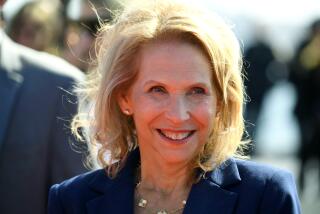Stock Value Propels Viacom’s Split Plan
- Share via
More than perhaps any other media mogul, Viacom Inc. Chief Executive Sumner Redstone grades himself on the vitality of his company’s stock price.
The 81-year-old’s net worth of $8 billion is closely tied to his 70% controlling stake in Viacom. He is famous for calling his broker during meetings for the latest trading activity.
Now Redstone’s legendary obsession with every tick of the stock is fueling his latest gambit: a proposal to split Viacom in two, perhaps by the end of the year.
It’s unclear how the idea first got traction. Several insiders said it was the brainchild of Bruce Wasserstein, chairman of investment banking firm Lazard Ltd. Others say Viacom co-president Tom Freston persuaded counterpart Leslie Moonves of the merits of a split and that Moonves in turn called in Wasserstein, who happens to be his cousin.
Wasserstein gave Redstone a formal presentation about a split a couple of weeks ago, sources said Thursday. Lazard is among several investment bankers working on the deal.
Whoever first suggested it, the potential bifurcation proved irresistible to Redstone because it would help appeal to two categories of investors.
For those who seek the dividends paid by big cash-generating properties, there would be one company, run by Moonves, overseeing CBS Television, the Infinity radio stations and the outdoor advertising group.
For investors who prefer stocks with bigger prospects for growth, there would be a cable and movie company, run by Freston, with such properties as MTV, Nickelodeon, BET and Paramount Pictures.
Some investors have been reluctant to buy Viacom stock because the firm is weighed down by slower-growing businesses.
On Thursday, Viacom Class B shares closed at $36.72, up 72 cents, or 2%, after trading as high as $38.65.
Redstone said his decision to pursue a breakup of the $60-billion company followed an exploration of various ways to unlock the stock’s value.
“I’ve been on this case for six months,” he said. “It has been an evolving plan to get the most out of this company.”
Spinning off or selling the troubled radio group was among the possibilities that sources close to the firm said had been considered and rejected. They said Viacom still saw value in radio and was unwilling, at a time when prices were so low, to sell a property for which it paid dearly.
The proposed division could also feed an appetite among investors for “pure plays.” While many media conglomerates with a smorgasbord of assets have seen their stocks stagnate, entertainment companies with more narrowly defined strategies are hot.
“What’s working right now are the pure plays like Pixar and DreamWorks” Animation SKG Inc., said Merrill Lynch analyst Jessica Reif Cohen.
Since being named Viacom co-presidents last summer, Moonves and Freston have been competing to succeed Redstone as CEO. Sources close to the two men said they were thrilled about the proposed division because it would give each a public company to run, with Redstone serving as chairman.
Yet there were mixed emotions in the corporate suites of Viacom on Thursday, as Redstone’s 250 employees tried to sort out what the split might mean for them. “They’ll all be out of jobs,” said one person close to the company, noting that Moonves and Freston might not want to hire Redstone loyalists.
Still, though some people could be let go, there will also surely be hiring. As another source noted, the breakup would necessitate the hiring of “two sets of everything: two treasurers, two general counsels, two CFOs.”
All this would cost money. By one estimate, to execute a split would cost as much as $200 million. And the companies would need to spend as much as $100 million more a year on two infrastructures.
*--*
(BEGIN TEXT OF INFOBOX)
The breakdown
Here is what the two new companies would look like.
Viacom’s 2004 revenue, by sector (In billions)
Cable and film:
Cable networks (MTV, Nickelodeon, Showtime, VH1, BET) $6.6
Entertainment (Paramount Pictures, theaters, theme parks) 4.1
Total 10.7
Broadcasting
Television (CBS, UPN, TV stations, Paramount TV) 8.5
Radio (Infinity Broadcasting) 2.1
Viacom Outdoor (Billboards, other advertising) 1.9
Total 12.5
Source: Merrill Lynch, Times research *--*
More to Read
The biggest entertainment stories
Get our big stories about Hollywood, film, television, music, arts, culture and more right in your inbox as soon as they publish.
You may occasionally receive promotional content from the Los Angeles Times.










